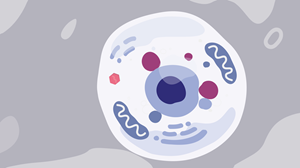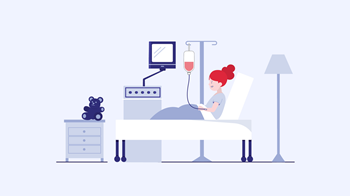Gaucher disease is a rare genetic disorder that causes the harmful buildup of glycolipids throughout the body. Gene therapy aims to be given one-time and may be designed to target specific organs to address symptoms caused by the effect the disease has on the brain.
About Gaucher Disease
 Cause of disease - There are three major forms of Gaucher disease known as Type 1, 2, and 3. Each type is caused by mutations (e.g. variants or changes) to the GBA gene. This gene is supposed to instructs cells to produce an enzyme called beta-glucocerebrosidase (GCase), which breaks down glycolipids in the lysosomes within the cells. Glycolipids are substances in the cell made up of sugar and fat. Lysosomes are often referred to as the “recycling center” of cells because they break down waste materials—allowing the body to function properly. As a result of the not working GBA gene, cells don’t make enough GCase enzyme. This causes waste (especially, glycolipids) to build up in organs of the body and become harmful.
Cause of disease - There are three major forms of Gaucher disease known as Type 1, 2, and 3. Each type is caused by mutations (e.g. variants or changes) to the GBA gene. This gene is supposed to instructs cells to produce an enzyme called beta-glucocerebrosidase (GCase), which breaks down glycolipids in the lysosomes within the cells. Glycolipids are substances in the cell made up of sugar and fat. Lysosomes are often referred to as the “recycling center” of cells because they break down waste materials—allowing the body to function properly. As a result of the not working GBA gene, cells don’t make enough GCase enzyme. This causes waste (especially, glycolipids) to build up in organs of the body and become harmful.
Symptoms – All three forms of Gaucher disease include issues of chronic fatigue, low blood counts, bleeding and bruising, and enlarged organs that may not function properly. People with Type 2 and Type 3 also have complications that affect the brain. This results in a loss of movement skills, low muscle tone and difficulty eating. The age of onset varies widely from infancy or childhood into adulthood, depending on the type and severity of the disease.
Gene Therapy Approach
.aspx?width=350&height=350) Gene therapy is being researched to potentially slow or stop disease progression through a one-time treatment that delivers a working GBA gene into cells. A viral vector is used to deliver the working gene into cells. Scientists know that viruses are good at getting into cells, so they have learned how to safely use this ability as a carrier to deliver working genes. But don’t worry, the viral genes are removed, so only therapeutic (intended) genes are delivered. Once delivered, the working GBA gene will instruct cells to produce the GCase enzyme which breaks down the toxic buildup of wastes in the lysosomes.
Gene therapy is being researched to potentially slow or stop disease progression through a one-time treatment that delivers a working GBA gene into cells. A viral vector is used to deliver the working gene into cells. Scientists know that viruses are good at getting into cells, so they have learned how to safely use this ability as a carrier to deliver working genes. But don’t worry, the viral genes are removed, so only therapeutic (intended) genes are delivered. Once delivered, the working GBA gene will instruct cells to produce the GCase enzyme which breaks down the toxic buildup of wastes in the lysosomes.
Clinical trials may differ on various aspects of their design. If you are considering a clinical trial, it would be best to discuss your options with a healthcare provider or a member of the clinical trial research team. At this time, people who have received one type of gene therapy approach will not be able to receive the other approach, so careful consideration must be given to whether participation in any gene therapy clinical trial is right for an individual.
 Using an in vivo or ex vivo approach - In vivo gene therapy is delivered directly into the body, meaning it is given as a single injection. Ex vivo gene therapy approach is done outside the body. In this approach, a person’s own hematopoietic stem cells (HSCs) are removed from the bone marrow or blood. HSCs are versatile cells that can develop into other types of cells. A viral vector is used to deliver the working GBA gene to the cells that were removed, and then these modified cells are returned to the body through an IV infusion. Prior to treatment, a process called conditioning will clear out space and prepare the patient’s body to receive these new modified cells.
Using an in vivo or ex vivo approach - In vivo gene therapy is delivered directly into the body, meaning it is given as a single injection. Ex vivo gene therapy approach is done outside the body. In this approach, a person’s own hematopoietic stem cells (HSCs) are removed from the bone marrow or blood. HSCs are versatile cells that can develop into other types of cells. A viral vector is used to deliver the working GBA gene to the cells that were removed, and then these modified cells are returned to the body through an IV infusion. Prior to treatment, a process called conditioning will clear out space and prepare the patient’s body to receive these new modified cells.
Routes of administration – Gene therapy for Gaucher disease can be given through different routes. One way is through an injection at the base of the skull, known as an intracisternal or intra-cisterna magna injection. The gene therapy is administered into a space containing fluid that surrounds the brain and spinal cord. Another approach is to inject the gene therapy into a vein, known as an intravenous injection. Then, the gene therapy travels throughout the body in the bloodstream.
Treatments and Pipeline
 There are treatment options available that can help manage symptoms of Gaucher disease, such as enzyme replacement therapy (ERT), which requires lifelong infusions and substrate reduction therapy (SRT) which require pills each day. However, these treatments do not address symptoms caused by the effect on the brain, so some may consider an investigational gene therapy as an option. There are also active preclinical research studies and clinical trials for Gaucher disease, including those studying the potential of gene therapy. Clinical trials are a required part of the research process that aims to understand the way a drug or treatment will interact with the human body and whether it is safe and effective. Preclinical studies are an even earlier stage of research to confirm the safety and effectiveness of a treatment in animal or cell-based models before proceeding with a human clinical trial.
There are treatment options available that can help manage symptoms of Gaucher disease, such as enzyme replacement therapy (ERT), which requires lifelong infusions and substrate reduction therapy (SRT) which require pills each day. However, these treatments do not address symptoms caused by the effect on the brain, so some may consider an investigational gene therapy as an option. There are also active preclinical research studies and clinical trials for Gaucher disease, including those studying the potential of gene therapy. Clinical trials are a required part of the research process that aims to understand the way a drug or treatment will interact with the human body and whether it is safe and effective. Preclinical studies are an even earlier stage of research to confirm the safety and effectiveness of a treatment in animal or cell-based models before proceeding with a human clinical trial.
To stay up to date on active and recruiting clinical trials that may become available in the U.S. or globally, visit ClinicalTrials.gov or the Gene Therapy Trial Browser.
Participating in a Clinical Trial
It is important to be well informed when deciding to participate in a clinical trial. Below are some key points to consider. Go to the considering a clinical trial page for more information and resources to help guide you.
-
 Eligibility - Eligibility for a trial is based on strict inclusion and exclusion criteria. These are specific factors that determine whether a person can or cannot enroll in a clinical trial. This is an important way for researchers to understand if the gene therapy is working properly and to ensure participant safety. These criteria may include factors such as age, how advance the disease is, or medical history, such as prior use of ERT. Speak with a healthcare provider or a member of the clinical trial research team to help determine if you or your child may be eligible for a clinical trial.
Eligibility - Eligibility for a trial is based on strict inclusion and exclusion criteria. These are specific factors that determine whether a person can or cannot enroll in a clinical trial. This is an important way for researchers to understand if the gene therapy is working properly and to ensure participant safety. These criteria may include factors such as age, how advance the disease is, or medical history, such as prior use of ERT. Speak with a healthcare provider or a member of the clinical trial research team to help determine if you or your child may be eligible for a clinical trial.
-
Risks – As with any medical intervention, there are risks that need to be carefully considered. Before participating in a clinical trial, a member of the research team should review any potential risks and benefits with the patient or caregiver. Therapies being studied in clinical trials are not a guaranteed cure and cannot guarantee beneficial results. There is always a chance that the investigational treatment may not work. In the event a person is not satisfied with the outcome, the person cannot receive another dose of the gene therapy. In addition, participating in a clinical trial may prevent future participation in other trials or from receiving other types of treatments. Gene therapy can be an alteration for the lifetime, so people should be aware that there could be long term effects (both good or bad) that are not known at this time.
-
Benefits – Participating in a trial may offer many potential benefits compared to not receiving any form of intervention for a fatal disease. Gene therapy aims to be a one-time treatment with lasting positive effects that slow or stop disease progression for a lifetime. However, there is no guarantee. If gene therapy is received earlier in the course of disease, it has the potential to stop any damage before it occurs.
-
Long-term follow up – It is the patient’s responsibility to comply with the long-term follow-up of a trial. The Food and Drug Administration (FDA) guidelines require the clinical trial research team to monitor safety and potential long-term effects of a gene therapy. Follow-up may require in-person appointments that vary in frequency and location, or completion of mailed packets with response forms. The need for long-term data collection for a gene therapy trial can last up to 15 years—another reason to consider all outcomes and responsibilities that come with committing to a clinical trial. There are a limited number of participants in trials so a lack of attendance at follow-up appointments leads to not enough study data. This could negatively affect FDA approval of a new therapy and thereby limit access to the therapy by patients who did not participate in the clinical trial.
Access
At this time, we do not know if or when gene therapies will be approved by the U.S. Food and Drug Administration (FDA) and commercially available for people living with different types of Gaucher disease. The overall process may take several more years, until it is deemed safe and effective by the FDA or the regulatory agency in other countries.
Stay Informed
There are many patient advocacy organizations to follow or get involved with. They work hard to fund research and advocate for patient and family needs. They are also a great way to connect with others affected by the disease if you are looking for support and advice.
Gaucher Community Alliance
International Gaucher Alliance
National Gaucher Foundation
National Gaucher Foundation of Canada
Was this information helpful? If so, please feel free to share these resources by referencing the Gaucher disease media kit!